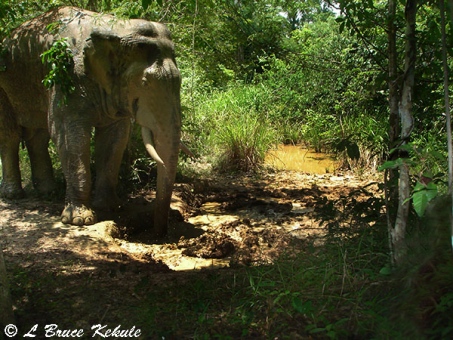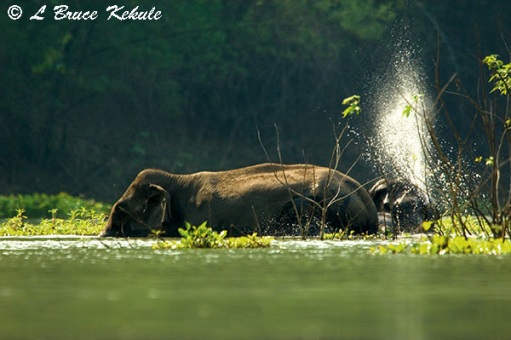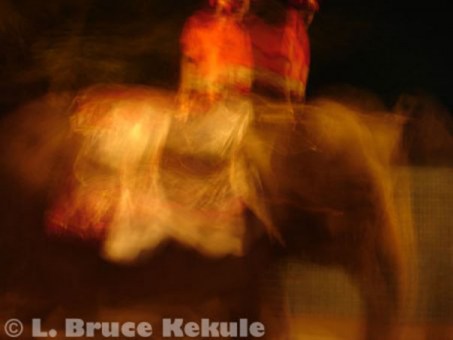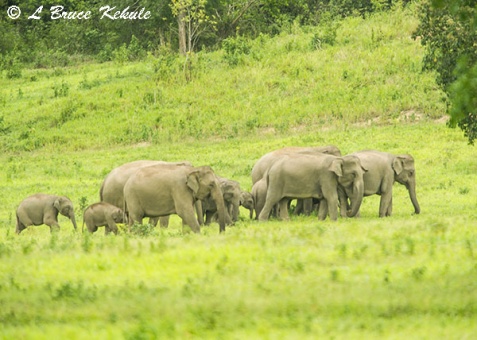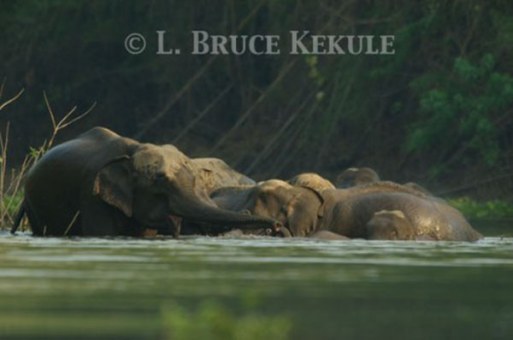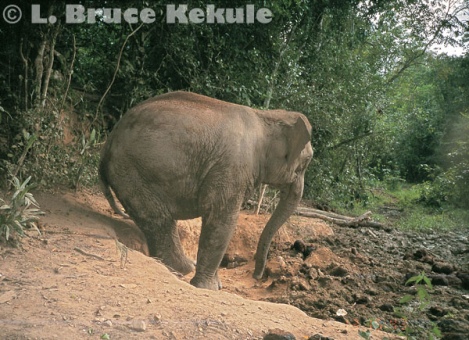Posts Tagged ‘Thailand’s elephants’
Thailand’s Vanishing Giants
A family unit in Khao Yai National Park.
Increasingly dangerous environment for wild elephants: An indicator species of a pristine forest
Of all the mammals in Thailand, the wild elephant is probably the most important indicator species of a disappearing wilderness. A century ago, there were more than a hundred thousand elephants found in the country when 75 percent of the Kingdom was still covered by forest. Just north and east of Bangkok, these huge mammals thrived in the marshlands and forests near the city.
But as time passed and humanity expanded creating cities and towns, roads and highways, railways, agriculture farmlands, golf courses and resorts, the home of the wild elephant began to disappear leaving many forests fragmentized and degraded. Populations of wild elephants went into serious decline. Humans are directly responsible for this loss with encroachment and poaching at the forefront. Forests and wildlife continue to disappear as we move into the 21st Century.
When Khao Yai, the first national park in Thailand was established in 1962, the Royal Forest Department (RFD) was in charge of protecting the forest. Prior to that, they controlled logging concessions and huge swathes of forest were felled in the timber business. Finally, the government stopped all logging in 1989. However, illegal tree felling is still going on to this day but on a smaller scale.
Tusker camera trapped in Khao Ang Rue Nai Wildlife Sanctuary, eastern Thailand.
Then in 1992, the Department of National Parks (DNP) was established to look after the national parks, wildlife sanctuaries, non-hunting areas and marine national parks. There are now over two hundred protected areas nation-wide.
Since then, it has taken many, many years for the department to establish some form of protection and enforcement. Patrolling of the forests has been minimal due to many factors. Unfortunately, things have been difficult for them to look after these biospheres because of low budgets and not enough personnel. Laws are seriously outdated especially when it comes to elephants.
Elephants in the Huai Kha Khaeng river blowing water.
The history of man and elephants in Asia has been intertwined for several thousand years. These majestic creatures taken from the wild have been part of human culture and beliefs. Elephants played a major role in the wars with Burma of the past. Until recently, the elephant was not only used for logging but for transport and baggage. More recently, they are used to attract tourists at camps and in cities where people use them for begging. The domestic elephant has been abused, and very badly in some cases.
Begging elephant in Chiang Mai – Abstract.
Probably the most appalling fate for a domesticated elephant is to become a streetwalker. These magnificent creatures are forced to walk hot, dusty and polluted streets of Thai cities ‘begging’ for food and money. Stories about elephants hit by cars and falling into drainage ditches, plus other accidents have been documented.
Ten years ago, it was guesstimated that 2,000 wild and 3,000 domestic elephants were thriving in the country. Due to an increased DNP and NGO interaction in the parks and sanctuaries, wild elephants have made a bit of a comeback in some protected areas. There are now (still guesstimated) to be about 3,000 wild elephants and more than 4,000 domesticated animals. Population density surveys have been carried out in some parks but exact numbers of the wild population are still uncertain.
Elephants on a truck bound for Chiang Mai.
The biggest threat to wild elephants is still the same. Poaching males for their ivory and females for their babies. Recent kills in Kaeng Krachan National Park in the Southwest have gone on for quite sometime due to poor protection and enforcement, and numbers of elephants have dropped.
Elephants in the savanna of Kui Buri National Park.
It is quite possible that they have migrated to Kui Buri National Park further south along a thin corridor along the Burmese border. Numbers in Kui Buri have increased 100 percent in the last five to ten years, and evidence of elephants in Prak Tha Kor Reserve Forest between the two parks has been documented. This area needs to be established as a protected area.
Elephant herd in Kui Buri National Park.
The following is a typical scenario of baby elephant snatching. Gunshots reverberate explosively through the forest, panicking and scattering a herd of wild elephants. The huge beasts instinctively flee as fast as they can through heavy foliage away from the cacophony. In minutes, the forest returns to normal. But the sad fact is that humans have just disrupted the herd permanently.
A large herd in Huai Kha Khaeng Wildlife Sanctuary.
A baby elephant mills aimlessly around its mother lying dead on the ground. The confused calf has no sense of danger as poachers move in to capture it to be sold on the illegal black market. The calf will likely be forced to wander city streets or work in tourist camps.
A small herd including a calf in the Huai Kha Khaeng river.
Such atrocities are still practiced by unscrupulous people intent on killing the mother solely to capture the baby. Many other animals are also hunted down in much the same way. Middleman, the ‘big-fish’ and end-use buyers perpetuate this market and seem to evade the law. When will this horror story ever stop?
A tusker and tourists in Khao Yai.
In another real-life scenario, a young tusker is killed on the road that transects the northern part of the elephant’s range in Khao Ang Rue Nai Wildlife Sanctuary in eastern Thailand. It is home to about 170 wild elephants. The road had been widened and resurfaced to enable faster speed.
Tuskless bull in Huai Kha Khaeng.
During late-evening one day in May 2002, a man and woman in a pickup truck barreling through the sanctuary at high speed did not see the elephants on the road until it was too late. The truck crashed head-on into a 5-year-old tusker. The truck’s driver was killed on impact but the woman survived. The young elephant died shortly after.
Tusker on the road in Khao Yai NP.
This young tusker was not the first and definitely will not be the last elephant to be killed by reckless driving on this road. Eventually, the local government ordered the road closed through Khao Ang Rue Nai from 9pm to 5am. The elephants come out of the forest usually only at night and can now roam safely in their own habitat. Accidents and road-kill have dropped drastically. Definitely a role model for other protected areas with elephant-human conflicts.
Another tusker on the road in Khao Yai N.P.
Such accidents are a terrible blow to the conservation of Thai elephants, because tuskers are particularly vulnerable, being subject to hunting for their ivory. Asian ivory is finer-grained than African ivory and prized for carving into trinkets and Japanese hanko (signature seals).
Herd in Kui Buri N.P.
Much of their habitat has been taken over, mainly by pineapple, sugarcane and cassava. Villages spring up in old elephant habitat, and the trespassers expect the giants to simply fade away into the forest. But elephants can develop a taste for crops grown by farmers, and they often take what they want. Countless conflicts have arisen between villagers and the real owners of the land, whose ancestors have lived there for many thousands of years.
Herd in the Huai Kha Khaeng river.
Elephants have been maimed and killed by poisoning waterholes, pungee stakes, gunshots, and electrocution. They have been chased out of rice paddies, mango orchards and farmlands. People use fireworks, bright lights and guns to scare them away temporarily, but the elephants are intelligent enough to lose their fear of such ruses.
Elephant on the highway north of Bangkok.
These giants grow bolder and go on the rampage, sometimes killing people, tearing up villages and damaging RFD and DNP facilities. Some conservation organizations have erected new signs warning of the danger of elephants in the area.
Elephant and handler begging near ‘700 Years’ Stadium in Chiang Mai.
A trip at night around some cities, one can still be greeted by a huge gray beast with a red light attached to its tail. Continuous calls for change go unnoticed by mahouts and the owners of these elephants who sneak them into tourist sites. Legislation concerning domesticated elephants remains old and out-dated, and law enforcement has also been very poor. On the positive side of things, the authorities have finally moved them out of Bangkok, but they still roam on the outskirts in some places.
Elephant in a mineral deposit in Kaeng Krachan N.P.
It is hoped that the RFD, DNP and other government organizations will draw attention to the dire situation of Thai elephants, both wild and domestic. These noble beasts have featured prominently in almost every important historical event in the Kingdom. They are a national symbol of pride and joy. The Thai elephants’ future survival lies in the hands of the government who are responsible for these amazing giants….!
Special Note:
I would like to thank Andy Merk, German wildlife photographer for the lead photograph. He has been hanging around Khao Yai for the last 20 some years and has a huge collection of elephant photos from the park. He is doing a survey of trying to get a estimate of the population by identifying individual elephants by their ears, specially the male tuskers and mature females.



